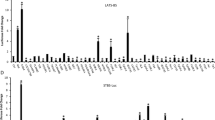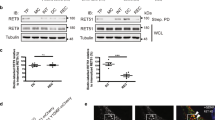Abstract
Signal transduction of the RET receptor tyrosine kinase is involved in developmental processes as well as in neoplastic transformation. Activation of RET initiates receptor autophosphorylation on specific tyrosines that act as docking sites for downstream signaling molecules. Using the cytoplasmatic part of RET as bait in a yeast two-hybrid screen, we identified a novel SH2 and SH3 domain containing adaptor protein previously termed Grap-2/Grf40/GrpL/GRID and its murine homologue as Gads/Mona, respectively. This protein, predominantly expressed in cells of hematopoietic origin, is involved in signaling downstream of the T-cell receptor and the receptor for monocyte colony-stimulating factor. Here, we show that Grap-2 is also expressed in neuroendocrine tumors and cell lines known to bear mutated forms of RET. Endogenously expressed RET and Grap-2 coimmunoprecipitate from lysates of a medullary thyroid carcinoma cell line. Grap-2 directly associates with RET in pull-down experiments using in vitro translated proteins. Overexpression of Grap-2 inhibits RET-induced NF-κB activation, and cotransfection of Grap-2 significantly reduces focus formation induced by oncogenic RET in NIH 3T3 cells. Taken together, these results suggest that besides being involved in tyrosine kinase signaling in hematopoietic cells, Grap-2 plays a tissue-specific role as an inhibitor of RET mitogenic signaling.
This is a preview of subscription content, access via your institution
Access options
Subscribe to this journal
Receive 50 print issues and online access
$259.00 per year
only $5.18 per issue
Buy this article
- Purchase on Springer Link
- Instant access to full article PDF
Prices may be subject to local taxes which are calculated during checkout




Similar content being viewed by others
References
Baloh RH, Enomoto H, Johnson Jr EM and Milbrandt J . (2000). Curr. Opin. Neurobiol., 10, 103–110.
Bourette RP, Arnaud S, Myles GM, Blanchet JP, Rohrschneider LR and Mouchiroud G . (1998). EMBO J, 17, 7273–7281.
Carlomagno F, Salvatore D, de Franciscis M, Quadro L, Panariello L, Colantuoni V and Fusco V . (1995). Biochem. Biophys. Res. Commun., 207, 1022–1028.
Evers BM, Ishizuka J, Townsend Jr CM and Thompson JC . (1994). Ann. N.Y. Acad. Sci., 733, 393–406.
Hansford JR and Mulligan LM . (2000). J. Med. Genet., 37, 817–827.
Jhiang SM . (2000). Oncogene, 19, 5590–5597.
Liu SK, Berry DM and McGlade CJ . (2001). Oncogene, 20, 6284–6290.
Liu SK, Fang N, Koretzky GA and McGlade CJ . (1999). Curr. Biol., 9, 67–75.
Ludwig L, Kessler H, Wagner M, Hoang-Vu C, Dralle H, Adler G, Böhm BO and Schmid RM . (2001). Cancer Res., 61, 4526–4535.
Lundqvist M, Mark J, Funa K, Heldin NE, Morstyn G, Wedell B, Layton J and Oeberg K . (1991). Eur. J. Cancer, 27, 1663–1668.
Qiu M, Hua S, Agrawal M, Li G, Cai J, Chan E, Zhou H, Luo Y and Liu M . (1998). Biochem. Biophys. Res. Commun., 253, 443–447.
Schedl A and Hastie ND . (2000). Curr. Opin. Genet. Dev., 10, 543–549.
Taraviras S and Pachnis V . (1999). Curr. Opin. Genet. Dev., 9, 321–327.
Yoder J, Pham C, Iizuka YM, Kanagawa O, Liu SK, McGlade J and Cheng AM . (2001). Science, 291, 1987–1991.
Acknowledgements
We thank S Fugmann, K Schwarz and JWG Janssen for providing amplified yeast two-hybrid libraries and for numerous valuable instructions. We are also indebted to E Hildt for continuous support and excellent suggestions throughout the work. This work was supported in part by grants from the government of Baden-Württemberg (Landesforschungs-Schwerpunkt) to Leopold Ludwig and from the Else Kröner-Fresenius-Stiftung to Bernhard O Böhm.
Author information
Authors and Affiliations
Corresponding author
Rights and permissions
About this article
Cite this article
Ludwig, L., Kessler, H., Hoang-Vu, C. et al. Grap-2, a novel RET binding protein, is involved in RET mitogenic signaling. Oncogene 22, 5362–5366 (2003). https://doi.org/10.1038/sj.onc.1206517
Received:
Revised:
Accepted:
Published:
Issue Date:
DOI: https://doi.org/10.1038/sj.onc.1206517
Keywords
This article is cited by
-
Validation of an oligo-gene signature for the prognostic stratification of ductal carcinoma in situ (DCIS)
Breast Cancer Research and Treatment (2016)
-
Analysis of gene expression profiles of hepatocellular carcinomas with regard to 18F-fluorodeoxyglucose uptake pattern on positron emission tomography
European Journal of Nuclear Medicine and Molecular Imaging (2004)



